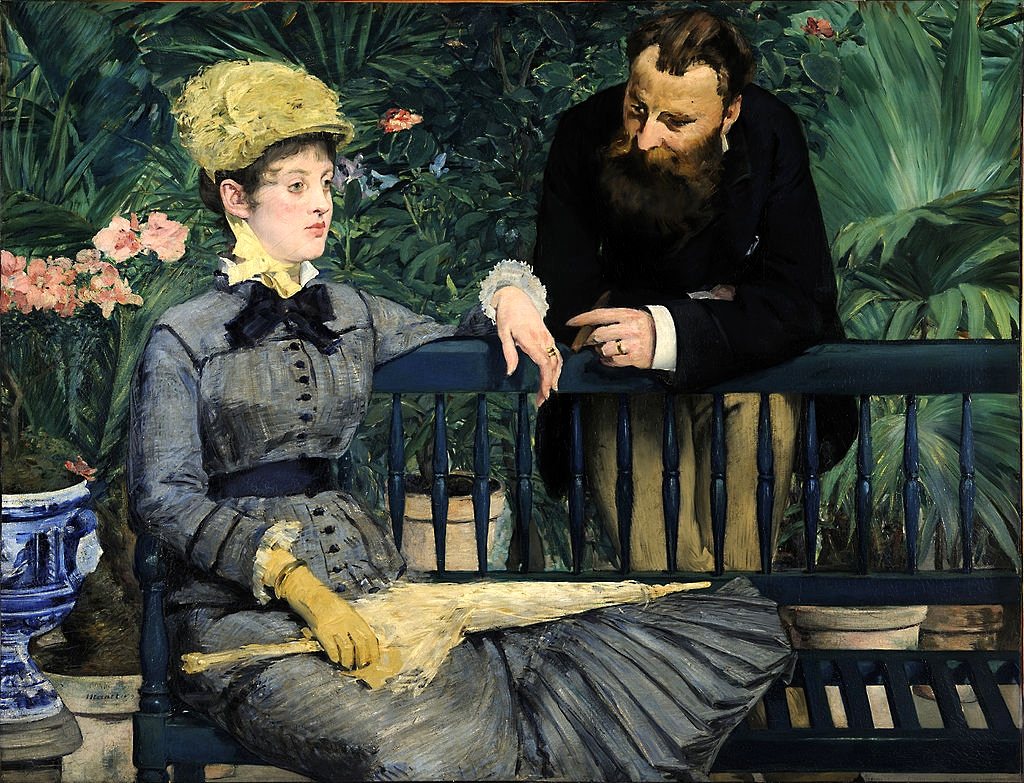EDOARD MANET
The Guitar Player
EDOARD MANET
Le Chemin de fer
EDOARD MANET
Olympia
EDOARD MANET
A Bar at the Folies-Bergère
EDOARD MANET
In the Conservatory
EDOARD MANET
Boating
EDOARD MANET
EDOARD MANET
Self-Portrait

EDOARD MANET
(1832-1883)
BIOGRAPHY
Born into a bourgeoisie household in Paris,
France, in 1832, Edouard Manet was fascinated
by painting at a young age. His parents disapproved
of his interest, but he eventually went to
art school and studied the old masters in
Europe. Manet's most famous works include
"The Luncheon on the Grass and Olympia."
Manet led the French transition from realism
to impressionism. By the time of his death,
in 1883, he was a respected revolutionary
artist.
Édouard Manet was the most important and
influential artist to have heeded poet Charles
Baudelaire's call to artists to become painters
of modern life. Manet had an upper-class
upbringing, but also led a bohemian life,
and was driven to scandalize the French Salon
public with his disregard for academic conventions
and his strikingly modern images of urban
life. He has long been associated with the
Impressionists; he was certainly an important
influence on them and he learned much from
them himself. However, in recent years critics
have acknowledged that he also learned from
the Realism and Naturalism of his French
contemporaries, and even from seventeenth
century Spanish painting. This twin interest
in Old Masters and contemporary Realism gave
him the crucial foundation for his revolutionary
approach.
Manet's modernity lies above all in his eagerness
to update older genres of painting by injecting
new content or by altering the conventional
elements. He did so with an acute sensitivity
to historical tradition and contemporary
reality. This was also undoubtedly the root
cause of many of the scandals he provoked.
He is credited with popularizing the technique
of alla prima painting. Rather than build
up colors in layers, Manet would immediately
lay down the hue that most closely matched
the final effect he sought. The approach
came to be used widely by the Impressionists,
who found it perfectly suited to the pressures
of capturing effects of light and atmosphere
whilst painting outdoors.
His loose handling of paint, and his schematic
rendering of volumes, led to areas of "flatness"
in his pictures. In the artist's day, this
flatness may have suggested popular posters
or the artifice of painting - as opposed
to its realism. Today, critics see this quality
as the first example of "flatness"
in modern art.
The Impressionism
Impressionism can be considered the first
distinctly modern movement in painting. Developing
in Paris in the 1860s, its influence spread
throughout Europe and eventually the United
States. Its originators were artists who
rejected the official, government-sanctioned
exhibitions, or salons, and were consequently
shunned by powerful academic art institutions.
In turning away from the fine finish and
detail to which most artists of their day
aspired, the Impressionists aimed to capture
the momentary, sensory effect of a scene
- the impression objects made on the eye
in a fleeting instant. To achieve this effect,
many Impressionist artists moved from the
studio to the streets and countryside, painting
en plein air.
In 1863, at the official salon, the all-important
event of the art world, a large number of
artists were not allowed to participate,
leading to public outcry. The same year,
the Salon des Refusés was formed in response
to allow the exhibition of works by artists
who had previously been refused entrance
to the official salon. Some of the exhibitors
were Paul Cézanne, Camille Pissarro, and
the early iconoclast Édouard Manet. Although
promoted by authorities and sanctioned by
Emperor Napoleon III, the 1863 exhibition
caused a scandal, due largely to the unconventional
themes and styles of works such as Manet's
Le déjeuner sur l'herbe (1863), which featured
clothed men and nude women enjoying an afternoon
picnic.
In 1884, another influencial exhibition started
up by the Société des Artistes Indépendants
which included many Impressionists. The Société
rebelled against the policies of the conservative
juries of Paris and would later come to be
a focal point for avant-garde activity and
a driving force for Modernism in Paris.
Édouard Manet was among the first and most
important innovators to emerge in the public
exhibition scene in Paris. Although he grew
up in admiration of the Old Masters, he began
to incorporate an innovative, looser painting
style and brighter palette in the early 1860s.
He also started to focus on images of everyday
life, such as scenes in cafes, boudoirs,
and out in the street. His anti-academic
style and quintessentially modern subject
matter soon attracted the attention of artists
on the fringes and influenced a new type
of painting that would diverge from the standards
of the official salon.
toward overbearing academic standards of
fine art, established at the time by the
influential Paris salon. The movement gained
its name after the hostile French critic
Louis Leroy, reviewing the first major Impressionist
exhibition, seized on the title of Claude
Monet's painting Impression, Sunrise (1873),
and accused the group of painting nothing
but impressions. The Impressionists embraced
the moniker, though they also referred to
themselves as the "Independents,"
referring to the subversive principles of
the Société des Artistes Indépendants and
the group's efforts to detach itself from
academic artistic conventions. Although the
styles practiced by the Impressionists varied
considerably (and in fact not all of the
artists would accept Leroy's title), they
were bound together by a common interest
in the representation of visual perception,
based in fleeting optical impressions, and
the focus on ephemeral moments of modern
life.
THE IMPRESSIONISM
IN ARTE EST LIBERTAS
ARTENCYCLOPAEDIA
MOVEMENTS-ARTISTS










